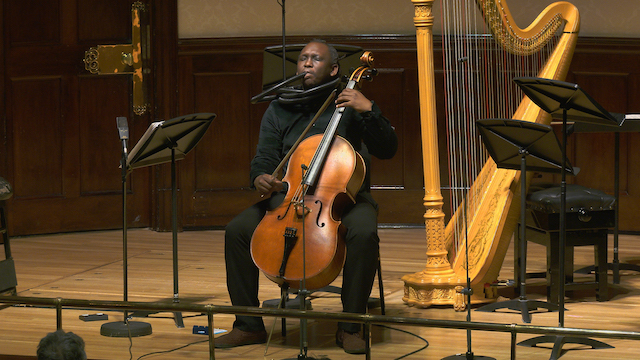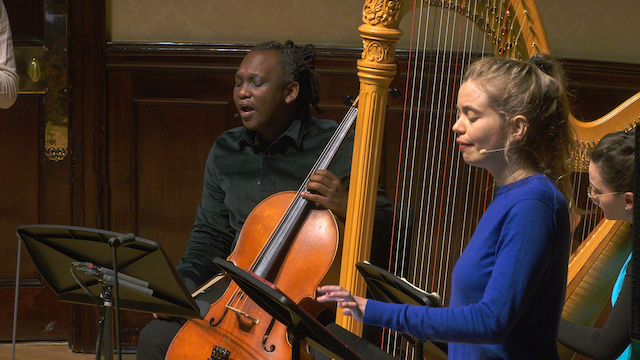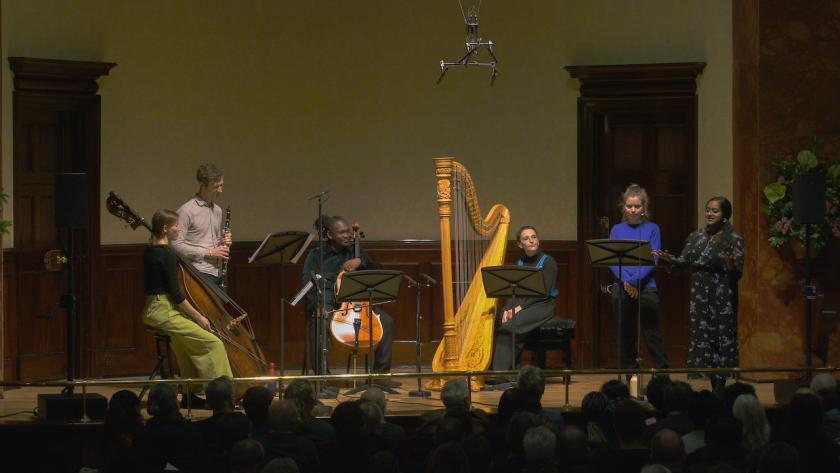There were points when this concert felt like the musical equivalent of watching the atom split – as well as notes there were animal shrieks, sinister rattles, sibilant serpentine sussurations, and primal throaty rumbles. Indian-American composer Shruthi Rajasekar, South African cellist and composer Abel Selaocoe (pictured below), and the never less than subversive Hermes Experiment unveiled a fascinating laboratory of noise in a lunchtime session that was as exhilarating as it was enjoyably unexpected.
The programme opened with Selaocoe, one of the most charismatic and radically experimental classical musicians of our time, performing his improvisatory Piece for solo cello and vocals. Steadily he built up the layers of sound through harmonics, gliding pizzicatos, the percussive slamming of his fingers on the fingerboard and the clattering of his bow on the strings. The effect was to make the whole cello hum with noise, an effect he added to with his own richly textured voice that at points sounded as if it was ringing out across the South African savanna and at others as if it had descended into the depths of the earth. Towards the end he unexpectedly added clips to the strings that just as unexpectedly pinged off onto the floor. Most surprisingly of all, he put what looked like a vacuum cleaner pipe round his neck (see below) before blowing it to produce a succession of haunting whistles.
This arresting start was followed by The Hermes Experiment coming on stage to perform his Buhle Bendalo for soprano, harp, clarinet and double bass, arranged by Benjamin Woodgates. The lyrics – written in Xhosa – were, as Selaocoe explained, an ode to how beauty deteriorates. As the harp, clarinet and double bass sinuously evoked the shifting textures of the natural landscape through flutters, echoes and rattles, the French-born soprano and composer Heloïse Werner demonstrated once more the anarchic versatility of her extraordinary voice. At some points the notes took on a metallic edge before morphing into animal cries, at others she shocked us with guttural weeping. Towards the end all the instrumentalists locked together in a clattering rhythmic chorus accompanied by syncopated rhythms on the harp and bass.
 This exhilarating odyssey through sound was followed by the witty experimentalism of four of Kerry Andrew’s fruit songs. Andrew – who is also a novelist – composed these songs to experiment with different vocal and phonetic effects. Originally written for guitar and voice, they had been rearranged by Hermes Experiment harpist Anne Denholm-Blair for the whole group. The first – plum – was ostensibly an apology from someone who had stolen plums from an ice box, but Werner used both pitch and enunciation to play with the words, whether in her biting pronunciation of “ice” or her tonal swoop into stratosphere to deliver the final word “cold”. The second song – blackberry – was a feast of plosive and sibilant sounds, accompanied by drumming on the harp and double bass, while cherry took us into a dimension filled with gasping, yapping and, at points, laughing. The final song, apple, filled with gorgeous images of green apples lit by, according to Werner’s deliberately exaggerated pronunciation, “silver moo-oo-oo-nlight”, was possibly the most surreal as it included a moment when Denholm-Blair produced a stick with an apple-like green orb at the top and slid it down the harp strings.
This exhilarating odyssey through sound was followed by the witty experimentalism of four of Kerry Andrew’s fruit songs. Andrew – who is also a novelist – composed these songs to experiment with different vocal and phonetic effects. Originally written for guitar and voice, they had been rearranged by Hermes Experiment harpist Anne Denholm-Blair for the whole group. The first – plum – was ostensibly an apology from someone who had stolen plums from an ice box, but Werner used both pitch and enunciation to play with the words, whether in her biting pronunciation of “ice” or her tonal swoop into stratosphere to deliver the final word “cold”. The second song – blackberry – was a feast of plosive and sibilant sounds, accompanied by drumming on the harp and double bass, while cherry took us into a dimension filled with gasping, yapping and, at points, laughing. The final song, apple, filled with gorgeous images of green apples lit by, according to Werner’s deliberately exaggerated pronunciation, “silver moo-oo-oo-nlight”, was possibly the most surreal as it included a moment when Denholm-Blair produced a stick with an apple-like green orb at the top and slid it down the harp strings.
Deliciously disorientated, we had now arrived at the centrepiece of the concert, the Indian-American composer Shruthi Rajakesar’s To ask is to listen, (composer pictured below) inspired by the fact that the two verbs have the same root in Tamil. Selaocoe now joined The Hermes Experiment as a cellist and vocalist, as the performers launched into what felt like a gallop at full tilt powered by rhythm and texture. Werner’s voice – sometimes going into full-throated freefall, sometimes whispering like steam as it starts to escape from the kettle – was nicely offset by Selaocoe’s throat singing and rumbling sussurations (see both pictured below). Throughout the instruments sustained the tension through idiosyncratic effects, whether it was the buzzing of the double bass, the wild riffs of the clarinet or the rattling of the harp.
 The final item was The Linden Tree, a composition by the jazz bassist Mishal Mullov-Abbado, arranged by Tom Parker and Amy Vanmeenen. In this pleasingly mellow finale, Oliver Pashley established the theme on the clarinet, which was subtly amplified on the harp before Marianne Schofield introduced a staccato rhythm on the double bass. Werner’s voice was more plaintive here as she sang from the old folk song, while the clarinet introduced more jazzy elements against a ripple of chords from the harp. In a beautiful improvisatory interlude, Selaocoe seemed to weave subtle ribbons of notes into the growing tapestry of sound, before Werner took the helm again and gently guided us towards the plangent finale.
The final item was The Linden Tree, a composition by the jazz bassist Mishal Mullov-Abbado, arranged by Tom Parker and Amy Vanmeenen. In this pleasingly mellow finale, Oliver Pashley established the theme on the clarinet, which was subtly amplified on the harp before Marianne Schofield introduced a staccato rhythm on the double bass. Werner’s voice was more plaintive here as she sang from the old folk song, while the clarinet introduced more jazzy elements against a ripple of chords from the harp. In a beautiful improvisatory interlude, Selaocoe seemed to weave subtle ribbons of notes into the growing tapestry of sound, before Werner took the helm again and gently guided us towards the plangent finale.















Add comment